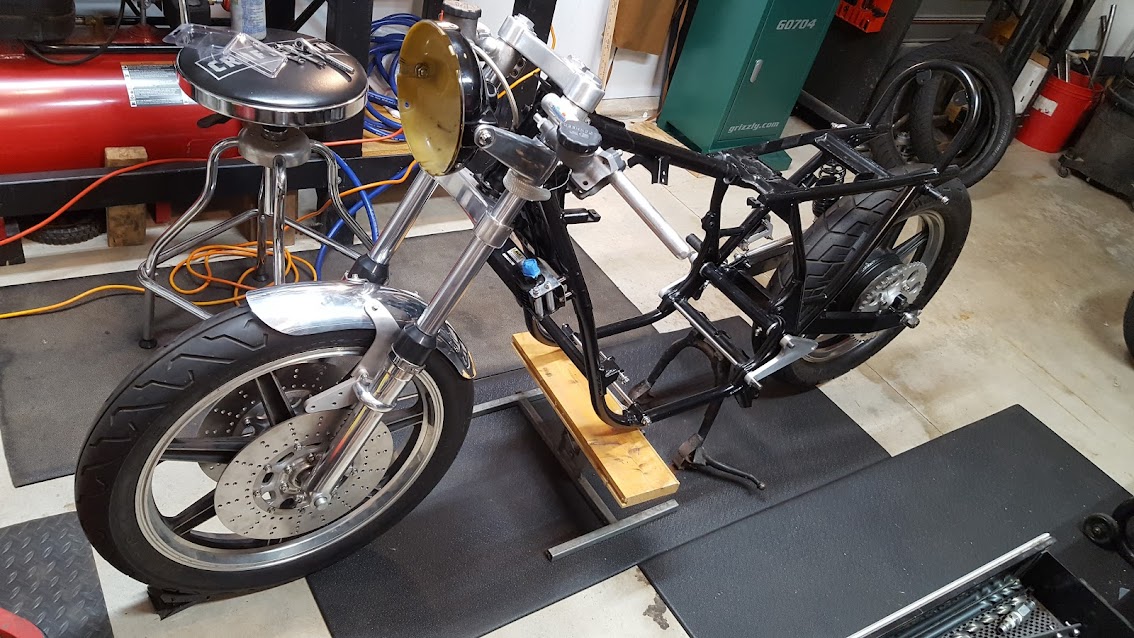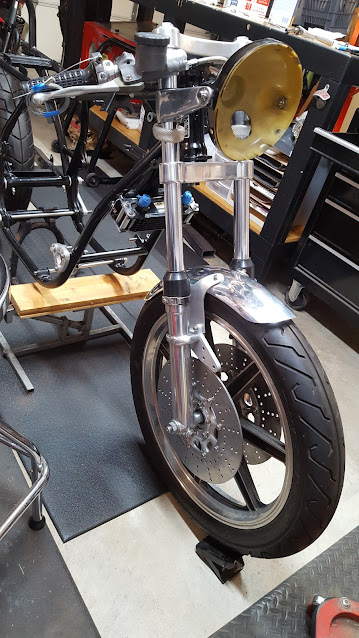There is in fact a very good reason for locating the calipers behind the fork legs rather than in front. The goal is to reduce the moment of inertia for the entire steering assembly. More technically the polar moment of inertia, the idea is the combination of mass and distance around a point of rotation. This is the difference you perceive between a very heavy door and a lighter one when you swing it open (or closed). The two doors appear to be identical, but the heavy one will take more effort to get moving and likewise coast a lot further (or slam better if you like). Alternatively, you could have a much bigger door, but if correspondingly lighter, it would seem the same as the smaller heavier door. You can look at the front end of your bike like a door with the hinge at the steering pivot, and the width of the bars, the weight of the controls, the diameter and weight of the wheel and weight and location of the brakes etc. etc.being the weight and size of the door.
This impacts steering, though not as some might expect. Having a super light steering assembly will indeed affect the steering, but only noticeably at parking lot speeds. The geometry (rake and trail) is really more important for how heavy or light the steering feels at any speed.
What is very important is this: All things have a natural frequency at which they will oscillate. Heavy things oscillate at lower frequencies, and lighter things oscillate at higher frequencies. Think tuning fork. This is the ringing you hear when you drop a coin. A similar phenomenon is present in assemblies with multiple components in motion. The natural frequency at which your steering assembly will oscillate is determined by many things, but primarily it is a function of its mass and how that mass is distributed in relation to its axis of rotation. You can increase the natural frequency of your steering assembly by making everything lighter, by making it more rigid, or my reducing the moment by moving weight closer to the axis of rotation. So moving those heavy brake calipers back behind the fork legs will move them closer to the steering axis, reduce the moment of inertia and cause the natural frequency of the whole assembly to increase. Making the wheel lighter, narrowing the bars, removing hand controls etc will have the same effect.
So why do you car about the natural frequency of your front end? You don't unless that frequency is able to get started by your operation of the bike. The coin in you hand does not start ringing by itself, but you can get it started by dropping it on the table. There is rather a lot going on with the front end of your bike when rolling down the road, and if the road were perfectly smooth, the tire perfectly round and if the rider never moved around on the bike all would be well at all speeds. However this is not the case in real life. Say you are traveling along at 100 mph on a smooth road and you hit a cigarette butt. This will deflect the tire a very tiny bit. The geometry of the steering system is inherently stable with the contact patch of the tire dragging behind the steering center generating forces that are enormous compared to the deflection so the steering returns to center and you never notice - but maybe not. There is mass in the steering. When the forces created by the steering geometry try to return the steering to straight, the mass wants to keep going and the assembly is deflected in the opposite direction. This is akin to the motion of one cycle of oscillation of the natural frequency of the assembly. At low speeds, this takes place at at a rate below the assembly's natural frequency, and without another cigarette but perfectly timed to follow the first the oscillation decays out. But as you travel faster and faster, the time it takes for this motion to be completed gets closer and closer to the natural frequency. At some speed, that tiny deflection will match the frequency of the assembly, and every swing of the steering returning to center will be helped along by the natural frequency of the system. The deflection you didn't even notice when you hit that cigarette will become larger and larger as long as the speed and the corresponding rate at which the geometry can return the system to neutral (straight ahead) matches the natural frequency. The dreaded speed wobble. Speed up, and the return to straight speed of the geometry falls out of sync with the natural frequency and the wobble goes away (of course you will have to slow down back through the danger zone eventually), or slow down for the same effect.
The world being what it is has conspired to make the typical natural frequency of a bikes front end be right in the range of typical top speeds. So if your bike tops out at 110 mph, and the moment of inertia and stiffness of your front end make for a harmonic at 100 mph, your effective top speed is a bit less than 100 mph because it will be obviously dangerous at the frequency matching 100 mph.
Reduce the moment of inertia by moving those heavy calipers considerably closer to the steering pivot, and the natural frequency will go up noticeably. Maybe it now takes 120 mph to match it. Now you can cruise safely at you top speed of 110 mph because the matching harmonic speed of your front end is out of reach.


You did run two of those right? one for me?
